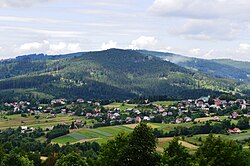Istebna
| Istebna | ||
|---|---|---|
| Village | ||

View of Istebna
|
||
|
||
| Coordinates: 49°33′50.75″N 18°53′35.82″E / 49.5640972°N 18.8932833°E | ||
| Country | Poland | |
| Voivodeship | Silesian | |
| County | Cieszyn | |
| Gmina | Istebna | |
| First mentioned | 1583 | |
| Government | ||
| • Mayor | Danuta Rabin | |
| Area | ||
| • Total | 47.41 km2 (18.31 sq mi) | |
| Population (2009) | ||
| • Total | 5,007 | |
| • Density | 110/km2 (270/sq mi) | |
| Time zone | CET (UTC+1) | |
| • Summer (DST) | CEST (UTC+2) | |
| Postal code | 43-470 | |
| Car plates | SCI | |
| Website | http://www.ug.istebna.pl | |
![]() Istebna is a large village and the seat of Gmina Istebna, Cieszyn County in Silesian Voivodeship, southern Poland. The village is situated in the Silesian Beskids mountain range, near to the borders with the Czech Republic and Slovakia, in the historical region of Cieszyn Silesia. Olza River flows through the village.
Istebna is a large village and the seat of Gmina Istebna, Cieszyn County in Silesian Voivodeship, southern Poland. The village is situated in the Silesian Beskids mountain range, near to the borders with the Czech Republic and Slovakia, in the historical region of Cieszyn Silesia. Olza River flows through the village.
The name is cultural in origin derived from the word (j)istba denoting a room in a (especially rural) house (see also ). It is conjectured that the name was conveyed by settlers from Istebné who supposedly established the village. Historically it was also subscribed as Gistebna (1621, 1629) or Istebne (1724; the name in plural form: rooms).
The village was first mentioned in the document from 1592 retrospectively mentioning the village Jistebne as existing in 1583. It belonged then to the Duchy of Teschen, a fee of the Kingdom of Bohemia and a part of the Habsburg Monarchy.
After Revolutions of 1848 in the Austrian Empire a modern municipal division was introduced in the re-established Austrian Silesia. The village as a municipality was subscribed to the political district of Cieszyn and the legal district of Jablunkov. According to the censuses conducted in 1880, 1890, 1900 and 1910 the population of the municipality grew from 2,112 in 1880 to 2,245 in 1910 with the majority being native Polish-speakers (between 98.2% and 99.5%) accompanied by German-speaking (at most 33 or 1.5% in 1890) and Czech-speaking people (at most 15 or 0.7% in 1880). In terms of religion in 1910 the majority were Roman Catholics (93.9%), followed by Protestants (5.9%) and Jews (6 people). The village was also traditionally inhabited by Silesian Gorals, speaking Jablunkov dialect.
...
Wikipedia


